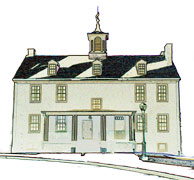


 | | | ||
 | | |||
 | | | | |
| | | |||
| | | |||
| Handwritten History by David Schmidt Main Line Life originally published November 7 - November 13, 2001 For Phil and Liz Eidelson, history is a real part oftheir lives.The Merion Station residentsmoved to the Main Lineseveral decades ago. Sincethen they've beendelighted with the depthand support of residents todiscover and maintainLower Merion's history,and they have joined inwith enthusiasm. Liz is the former chief librarian ofLower Merion's Ludington Library inBryn Mawr, and that's a position thatbrings you intodaily contact withthe 300 years oflocal history. Addto that the fact thatlibrarians, throughtheir very love ofbooks, are history'spreserversand organizers. For Phil, it'sbeen a more hightechapproach.Through his wife,he got involved increating computercopies of documentsthat were apart of the LudingtonLibrarycollection. In addition,he created adatabase of materialfrom newspaperclippings,numbering some 3,500 documents.The advantage of a database is thatpeople can search it by keywords andfind references without wadingthrough reams of ancient papers. That led to assisting the LowerMerion Historical Society by scanninginto computer files many of the papersand materials that the society wants topreserve electronically. He has alsocreated a database for them of some14,000 documents, again making itpossible for researchers to use thecomputer to find materials instead ofsearching through the drawers ofnumerous filing cabinets stuffed withfolders. He continues to do this, butthe two of them tookon a new challenge-trying to solve a mystery. One of the largest collections heldby the society is still being cataloged,and that is the Roberts family papers.In fact, it was hard to determine whatsome of the materials were or whattheir importance was. In these boxes ofmaterials, society members found avery unusual document, a history ofLower Merion dated 1888. The history gives no indication ofwho wrote it or why it was in theRoberts papers. The narrative refers toseveral membersof the Robertsfamily, but not ina way thatdefines a relationship. "It could havebeen written byone of the familymembers then,they were certainlygoodrecord keepers,"said Phil Eidelson."But it's justas likely that afamily memberhired someone toproduce therecord." There is onereference to landrented "from mygrandfather" fora fishery. The first Fishery within the Townshipbounds was at what is now Pencoyd.The only fishermen the writerhas ever heard of at this Fishery wereTobias and William Miller who rented[from] my grandfather about the commencementof this century for $60.00per year. These men were quite notedfishermen too. This quote by itself isn't enough todetermine authorship, but if it were aRoberts, it might even have beenghostwritten for the purposeof eventually publishingit. At that time, itwasn't unusual forwealthy men to writeand publish booksabout themselves,their families or topics whichinterested them. Called "vanity books,"these would be produced in smallamounts and given to friends, whoundoubtedly read them with undyingenthusiasm. In the case of this manuscript, itobviously was never finished, becausethere is a list of chapters, and not all ofthem are written. "Perhaps the author put is aside andnever came back to it," said Liz. "Butthe writer was an educated man, andhe must have had to do a great deal ofresearch." It is intriguing is to look back a centuryand read the musings of someoneelse who is looking back a century.There are several long lists of peopleand facts about them, such as howmuch they paid in taxes, who ownedsome of the land in earlier days andother information clearly receivedfrom governmental sources. Some of the more interesting sectionsdiscuss common people and theirlives, but one of the more edifying wasa section on cemeteries. In addition todocumenting the number of people"awaiting the summons of the lastday" the manuscript reproduces someof the more compelling tombstonesand their inscriptions. For example: The quaintest epitaph is that onstone of George Horn who departedthis life July 29th 1813 aged 75 years 4months 19 daysThis Man Was Honest FaithfulJust And True His Life ToCopy Ought To Be Our ViewBut Death Has ConqueredAfter Extreme Pain And OurDeep Loss Is His Eternal Gain There is also a fairly long sectiondealing with taverns and places todrink or "tipple." This was apparentlyan important dichotomy, as drinkingwas frowned upon, but the taverns andbars were gathering places thatallowed the spirit of community togrow. The only other prominent socialcenters inthose days were thechurches. So this manuscript providesa captivating look atLower Merion more than acentury ago. But the firststep was to make it readable. "The handwriting wasquite good, but it still wasn'talways clearly legible," saidLiz, "Not only that, you hadto deal with how languageusage has changed in the pastcentury." In addition to the Eidelsons,Ann Bagley of Merionand Gerald and Denise Francisof Bala Cynwyd worked on the"translation." Phil and Liz weregiven a draft and asked to do thefinal work of deciphering it. To do the work, they calledon their experience - as well as amagnifying glass. "A lot of the time it was reallyhelpful to use the magnifyingglass to study a word while tryingto figure out what it was. In one ofthe first paragraphs of the work isthe word 'progeny,' and that tookus forever to figure out until itfinally made sense," Phil said. One of the challenges was thatpeople at that time would often useobscure Biblical references in theirwriting, and sentence structure wassignificantly more complex thantoday. Add to it much more creativityof spelling and the task was no longermerely transcribing someone's handwrittenwords into a computer document. The manuscript is now complete,but is a living document and will probablycontinue to be massaged, filling inblank spots and defining obscure references.There will be a possibility of alog of people adding their two cents asthe document will soon be available atthe Lower Merion History Society'sWeb site,(http://www.lowermerion.org).
|